Updated October 28, 2023

| Label (Company) |
|
|
| Country |
|
|
| Format |
|
|
| Number of records |
|
|
| Catalogue number |
|
|
| Catalogue number of side 1 |
|
|
| Catalogue number of side 2 |
|
|
| Matrix number of side 1 |
|
|
| Matrix number of side 2 |
|
|
| Mono or Stereo |
|
|
| Rotation speed, rpm |
|
|
| First release date |
|
Click on image to enlarge
Натисніть на картинку, щоб її збільшити
FIRST PRESSING (released March 27, 1970)
ПЕРШИЙ ПРЕС (видання 27 березня 1970 року)
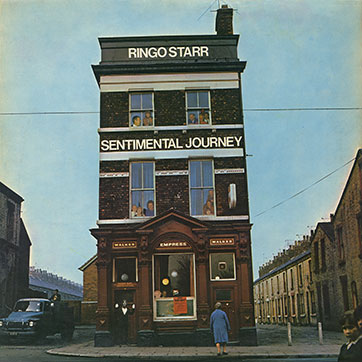 |
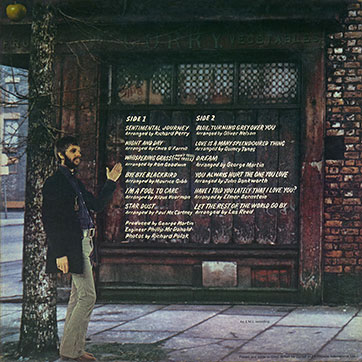 |
|
Var. dark, front side Вар. dark, лицьова сторона |
Var. dark, back side Вар. dark. зворотний бік |
![]()
Spine (var. 1) – the front side of the cover up
Корінець (вар. 1) – обкладинка розташована лицьовою стороною до гори
INNER SLEEVE
ВНУТРІШНІЙ ПАКЕТ
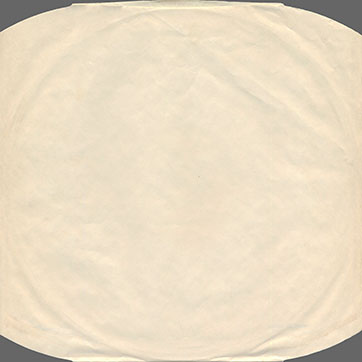 |
 |
|
Front side Лицьова сторона |
Back side Зворотний бік |

Back side (left and right lower corners)
Зворотний бік (лівий і правий нижні кути)
LABELS
ЕТИКЕТКИ
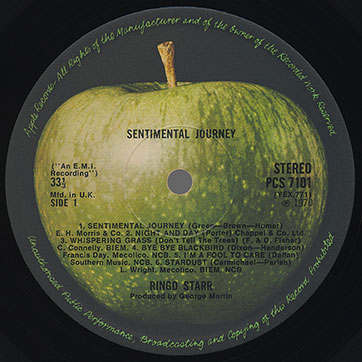 |
 |
|
Var. dark apple, side 1 Вар. dark apple, сторона 1 |
Var. dark apple, side 2 Вар. dark apple, сторона 2 |
REISSUE (circa 1974-1975)
ПЕРЕВИДАННЯ (приблизно 1974-1975 років)
 |
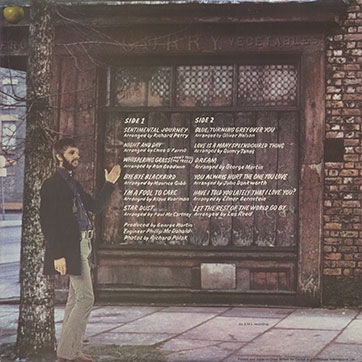 |
|
Var. light, front side Вар. light, лицьова сторона |
Var. light, back side Вар. light. зворотний бік |
![]()
Spine (var. 2) – the front side of the cover up
Корінець (вар. 2) – обкладинка розташована лицьовою стороною до гори
LABELS (light Apple)
ЕТИКЕТКИ (світле Яблуко)

Side 1 of reissue (var. A and var. B) Сторона 1 перевидання (вар. A та вар. B) |
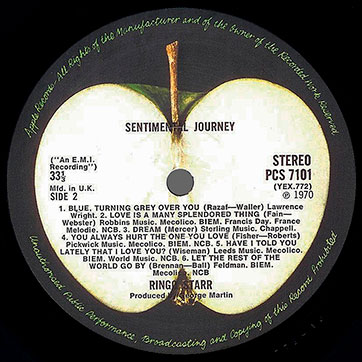 |
|
|
Side 2 of reissue (var. A) Сторона 2 перевидання (вар. A) |
||
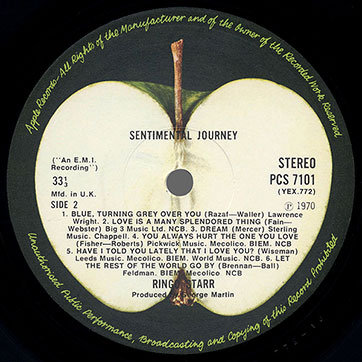
|
||
|
Side 2 of reissue (var. B) Сторона 2 перевидання (вар. B) |
SIDE 1
N |
Titles and authors |
Time |
Comments |
1 |
SENTIMENTAL JOURNEY (Green - Brown - Homer) | 3:26 |
Arranged by Richard Perry. *Originally recorded by Les Brown Band in 1945, with Doris Day on vocals, and became her first number one in America. |
2 |
NIGHT AND DAY (Porter) | 2:25 |
Arranged by Chico O'Farrill. *Originally from the 1932 musical, "The Gay Divorcee" and sung by Fred Astaire and Claire Luce. |
3 |
WHISPERING GRASS (DON'T TELL THE TREES) (F. & D. Fisher) | 2:37 |
Arranged by Ron Goodwin. *Originally recorded by the Ink Spots in 1940. |
4 |
BYE BYE BLACKBIRD (Dixon - Henderson) | 2:11 |
Arranged by Maurice Gibb. *Written in 1927 for vaudeville star George Price. |
5 |
I'M A FOOL TO CARE (Daffan) | 2:39 |
Arranged by Klaus Voorman. *Written in 1948, became a hit in 1954 for Les Paul and Mary Ford. |
6 |
STARDUST (Carmichael - Parish) | 3:22 |
Arranged by Paul McCartney. *Hoagy Carmichael wrote the tune in 1927, with the words added in 1929. Ringo was probably familiar with the 1957 hit version by Billy Ward and the Dominoes. |
SIDE 2
N |
Titles and authors |
Time |
Comments |
1 |
BLUE, TURNING GREY OVER YOU (Razaf - Waller) | 3:19 |
Arranged by Oliver Nelson. *Originally recorded by Louis Armstrong in 1930. |
2 |
LOVE IS A MANY SPLENDOURED THING (Fain - Webster) | 3:05 |
Arranged by Quincy Jones. *An Oscar winning song from 1955, and a chart hit for the Four Aces. |
3 |
DREAM (Mercer) | 2:42 |
Arranged by George Martin. *Written in 1945, a hit for the Pied Pipers. |
4 |
YOU ALWAYS HURT THE ONE YOU LOVE (Fisher - Roberts) | 2:20 |
Arranged by Johnny Dankworth. *A hit in 1944 for the Mills Brothers. |
5 |
HAVE I TOLD YOU LATELY THAT I LOVE YOU? (Wiseman) | 2:44 |
Arranged by Elmer Bernstein. *Originally recorded in 1946 by Foy Willing and the Riders of the Purple Sage. |
6 |
LET THE REST OF THE WORLD GO BY (Brennan - Ball) | 2:55 |
Arranged by Les Reed. *The oldest song on this release, dating from 1919, and originally by George J. Trinkaus and his band. But Ringo and his family would probably have been more familiar with the 1944 Dick Haymes version. |
* - additional information
Produced by George Martin.
Ringo Starr - Lead Vocals.
George Martin Orchestra - All instrumentation.
NOTE
Ringo Starr's debut album was composed entirely of covers of compositions that he first heard as a child on old records kept in his family. Unfortunately, Ringo himself hardly remembers who performed these songs. Original compositions from the most famous performers are collected here.
The cover of the first issue is fully laminated and has a dark shade. On the back of the cover in the upper left corner is the Apple Records logo, at the bottom are two lines: "Printed and made in Great Britain by Garrod and Lofthouse International Ltd." (at the very bottom) and at a considerable distance above it - "An E.M.I recording." The catalog number is indicated on the spine of the cover.
The record is inserted into a typical factory inner white bag with rounded corners. On one side of the bag, at the bottom, on the left side, is printed 'PATENT NO 1.125.555.', on the right side – 'MADE IN ENGLAND'.
Around 1974-1975, a reissue of this album was released. The record was printed from the same matrices as the first release, so the matrix numbers remained the same.
Compared to the first issue, there were some minor changes in the design: the tone of the cover and the apples on the labels became lighter, the spine was slightly wider.
Other changes affected the placement of text on labels.
Side 1:
• the spaces between the lines have increased on the right and left sides [see Pic. 1];
• the copyright sign for the sound recording ℗ has changed from small to large Ⓟ.
Side 2 has two versions: A and B.
• version A has no changes, completely coincides with side 2 of the first release;
• in version B, the changes are similar to the changes on side 1: the spaces between the lines have increased on the right and left sides and the ℗ sign has increased in size [see Pic. 2], in addition, the number of lines in the song list has changed [see Pic. 3], which is due to the change in credits in some songs. This version is much less common.
In both the first edition and the reissue, the title of the two songs has different spellings on the cover and label:
• STAR DUST (on the cover) and STARDUST (on the label);
• LOVE IS A MANY SPLENDOURED THING (on the cover) and LOVE IS A MANY SPLENDORED THING (on the label).
STAR DUST or STARDUST.
Unlike British English, in American English the word stardust can be written as two words – star dust. The author of this song, Hoagy Carmichael, wrote the song in 1927 under the name Star Dust, later renaming it Stardust in 1929.
SPLENDOURED or SPLENDORED.
Both words have the same meaning. The word splendour is used in British English (in Great Britain, Australia, New Zealand), and splendor is used in American English. Since the song is by American authors, they write splendored.
All the album's credits (authors of the compositions, musicians, thanks, etc.) are given in the English part of the text.


Pic. 1. Side 1of the first edition (top) and reissue (bottom)
Мал. 1. Сторона 1 першого видання (вгорі) та перевидання (внизу)



Pic. 2. Side 2 of the first edition (top) and reissue (var. A – middle; var. B – bottom)
Мал. 2. Сторона 2 першого видання (вгорі) та перевидання (вар. А – в середині; вар. В – внизу)


Pic. 3. Text on side 2 of the reissue: var. A (top) and var. B (bottom)
Мал. 3. Відмінності в тексті етикеток сторони 2 перевидання вар. A (вгорі) та вар. B (внизу)
ПРИМІТКА
Дебютний альбом Рінго Старра повністю складений із каверів на композиції, які він чув у дитинстві на старих платівках, що зберігалися в його родині. На жаль, зараз Рінго вже не може згадати, в чиєму виконанні лунали ці записи. Композиції в оригінальному виконанні найбільш відомих виконавців зібрані тут.
Обкладинка першого випуску повністю ламінована і має темний відтінок. На задньому боці обкладинки у верхньому лівому кутку нанесено логотип Apple Records, у нижній частині надруковано у 2 рядки: "Printed and made in Great Britain by Garrod and Lofthouse International Ltd." (у самому низу) і на значній відстані над нею − "An E.M.I. Recording.". Каталожний номер вказано на корінці обкладинки.
Платівка розташована у стандартному заводському внутрішньому пакеті білого кольору з округленими кутами. На зворотному боці пакету у низу з лівого боку надруковано "PATENT NO. 1.125.555.", з правого – "MADE IN ENGLAND"..
Приблизно в 1974 - 1975 роках вийшло перевидання цього альбому. Платівку відпресували з тих самих матриць, що й перший випуск, тому матричні номери залишилися тими самими.
Порівняно з першим випуском були невеликі зміни в оформленні: загальний тон обкладинки та колір яблука на етикетках стали світлішими, а корінець трохи ширшим.
Інші зміни торкнулися розміщення тексту на етикетках.
Сторона 1:
• у правій і лівій частині збільшилися проміжки між рядками [див. Мал. 1];
• знак авторського права на звукозапис ℗ змінився з маленького на великий Ⓟ.
Сторона 2 має два підваріанти: А та В.
• варіант А без змін, повністю збігається зі стороною 2 першого випуску;
• у варіанті В зміни аналогічні змінам на стороні 1: у правій і лівій частинах збільшилися проміжки між рядками та збільшився в розмірі знак ℗ [див. Мал. 2], крім того, змінилася кількість рядків у переліку пісень [дивю Мал. 3], що пов'язано зі зміною кредитів у деяких піснях. Цей варіант зустрічається значно рідше.
Як у першому виданні, так і в перевиданні назва двох пісень має різне написання на обкладинці та етикетці:
• STAR DUST (на обкладинці) та STARDUST (на етикетці);
• LOVE IS A MANY SPLENDOURED THING (на обкладинці) та LOVE IS A MANY SPLENDORED THING (на етикетці).
STAR DUST або STARDUST.
На відміну від британської англійської, в американській англійській слово stardust може писатися у два слова − star dust. Автор цієї пісні, Хогі Кармайкл, написав пісню 1927 року під назвою Star Dust, пізніше перейменувавши її на Stardust 1929 року.
SPLENDOURED або SPLENDORED.
Обидва слова мають одне й те саме значення. Слово splendour використовується в британській англійській (у Великій Британії, Австралії, Новій Зеландії), а splendor − в американській англійській. Оскільки пісня американських авторів, то пишуть splendored.
Усі вихідні дані щодо альбому (автори композицій, музиканти, подяки тощо) наведено в англійській частині примітки.